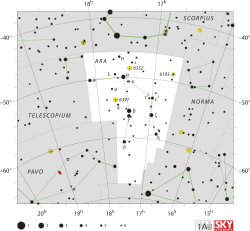Lambda Arae
Lambda Arae (λ Ara, λ Arae) is the Bayer designation for a star in the southern constellation of Ara. It is at a distance of 70.0 light-years (21.5 parsecs) from Earth.[1] The apparent visual magnitude of this star is 4.77,[2] making it bright enough to be seen with the naked eye.
 | |
| Observation data Epoch J2000 Equinox J2000 | |
|---|---|
| Constellation | Ara |
| Right ascension | 17h 40m 23.82481s[1] |
| Declination | –49° 24′ 56.1015″[1] |
| Apparent magnitude (V) | 4.77[2] |
| Characteristics | |
| Spectral type | F4 V[3] |
| U−B color index | –0.04[2] |
| B−V color index | +0.40[2] |
| R−I color index | 0.22 |
| Variable type | 3.10[4] |
| Astrometry | |
| Radial velocity (Rv) | +3.6[4] km/s |
| Proper motion (μ) | RA: +103.22[1] mas/yr Dec.: –176.51[1] mas/yr |
| Parallax (π) | 46.62 ± 0.33[1] mas |
| Distance | 70.0 ± 0.5 ly (21.5 ± 0.2 pc) |
| Absolute magnitude (MV) | +3.06[5] |
| Details | |
| Luminosity | 4.6[6] L☉ |
| Surface gravity (log g) | 4.15[6] cgs |
| Temperature | 6,725[6] K |
| Metallicity [Fe/H] | –0.24[4] dex |
| Rotational velocity (v sin i) | 15.5[7] km/s |
| Other designations | |
| Database references | |
| SIMBAD | data |
The spectrum of this star matches a stellar classification of F4 V,[3] which places it among the category of F-type main sequence stars. It shines with 4.6 times the luminosity of the Sun. The outer atmosphere is radiating this energy at an effective temperature of 6,725 K,[6] giving it the yellow-white hue of an F-type star. There is some evidence that this may be a binary star system consisting of two stars with identical masses.[7]
Examination of Lambda Arae with the Spitzer Space Telescope shows an excess of infrared emission at a wavelength of 70 μm. This suggests it may be orbited by a disk of dust at a radius of more than 15 astronomical units[9]
References
- van Leeuwen, F. (November 2007), "Validation of the new Hipparcos reduction", Astronomy and Astrophysics, 474 (2): 653–664, arXiv:0708.1752, Bibcode:2007A&A...474..653V, doi:10.1051/0004-6361:20078357
- Johnson, H. L.; et al. (1966), "UBVRIJKL photometry of the bright stars", Communications of the Lunar and Planetary Laboratory, 4 (99), Bibcode:1966CoLPL...4...99J.
- Gray, R. O.; et al. (July 2006), "Contributions to the Nearby Stars (NStars) Project: spectroscopy of stars earlier than M0 within 40 pc-The Southern Sample", The Astronomical Journal, 132 (1): 161–170, arXiv:astro-ph/0603770, Bibcode:2006AJ....132..161G, doi:10.1086/504637.
- Holmberg, J.; Nordstrom, B.; Andersen, J. (July 2009), "The Geneva-Copenhagen survey of the solar neighbourhood. III. Improved distances, ages, and kinematics", Astronomy and Astrophysics, 501 (3): 941–947, arXiv:0811.3982, Bibcode:2009A&A...501..941H, doi:10.1051/0004-6361/200811191.
- Ammler-von Eiff, M.; Reiners, A. (June 2012), "New measurements of rotation and differential rotation in A-F stars: are there two populations of differentially rotating stars?", Astronomy & Astrophysics, 542: A116, arXiv:1204.2459, Bibcode:2012A&A...542A.116A, doi:10.1051/0004-6361/201118724.
- Mallik, Sushma V. (December 1999), "Lithium abundance and mass", Astronomy and Astrophysics, 352: 495–507, Bibcode:1999A&A...352..495M
- Fuhrmann, K.; et al. (August 2011), "Evidence for the nearby F4V star λ Ara as a binary system", Monthly Notices of the Royal Astronomical Society, 415 (2): 1240–1243, Bibcode:2011MNRAS.415.1240F, doi:10.1111/j.1365-2966.2011.18764.x.
- "lam Ara". SIMBAD. Centre de données astronomiques de Strasbourg. Retrieved 2010-07-30.
- Lawler, S. M.; et al. (November 2009), "Explorations Beyond the Snow Line: Spitzer/IRS Spectra of Debris Disks Around Solar-type Stars", The Astrophysical Journal, 705 (1): 89–111, arXiv:0909.0058, Bibcode:2009ApJ...705...89L, doi:10.1088/0004-637X/705/1/89